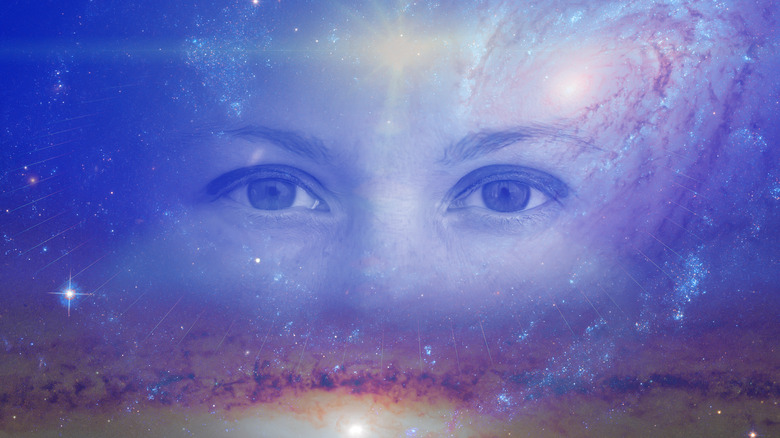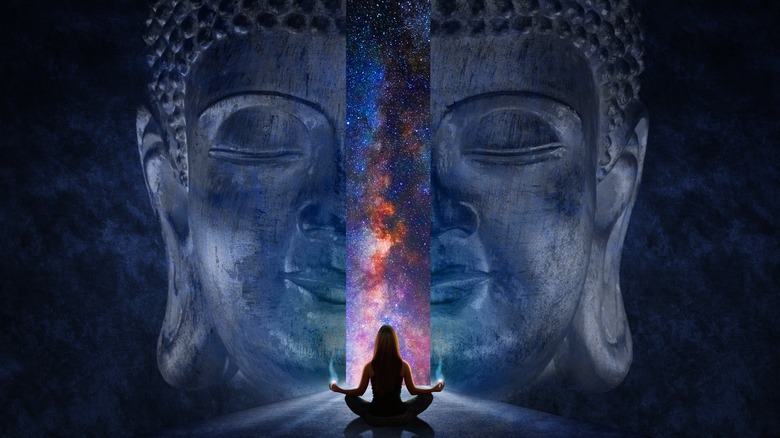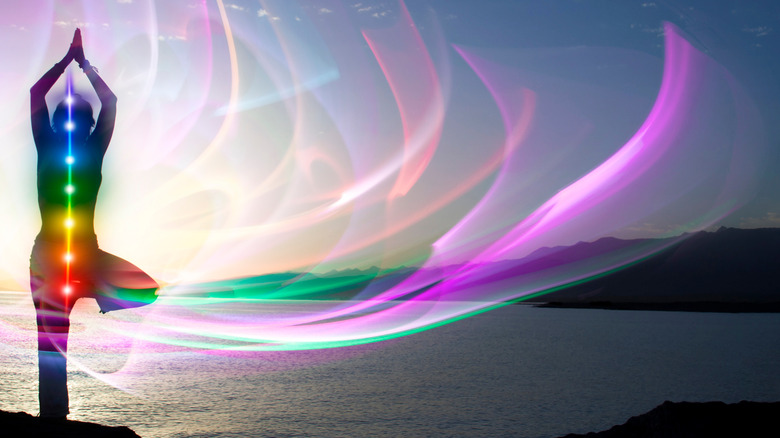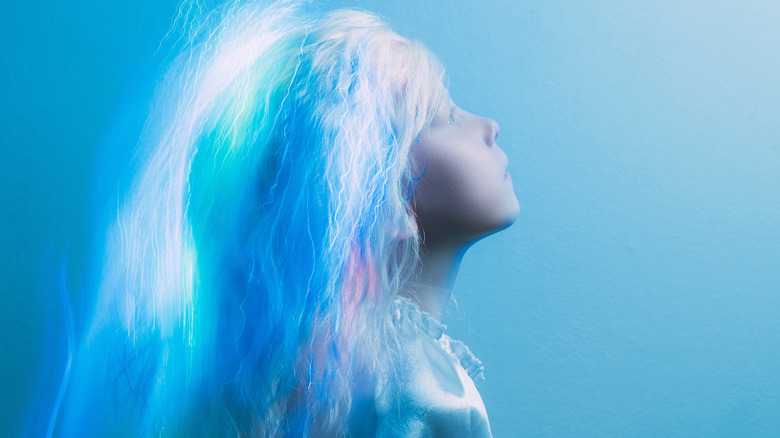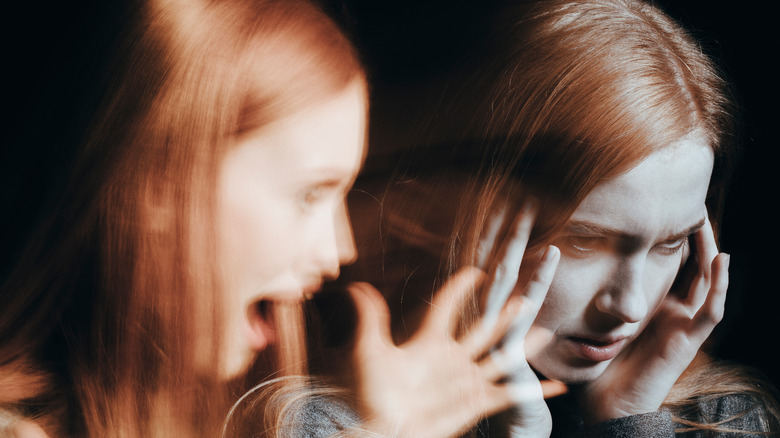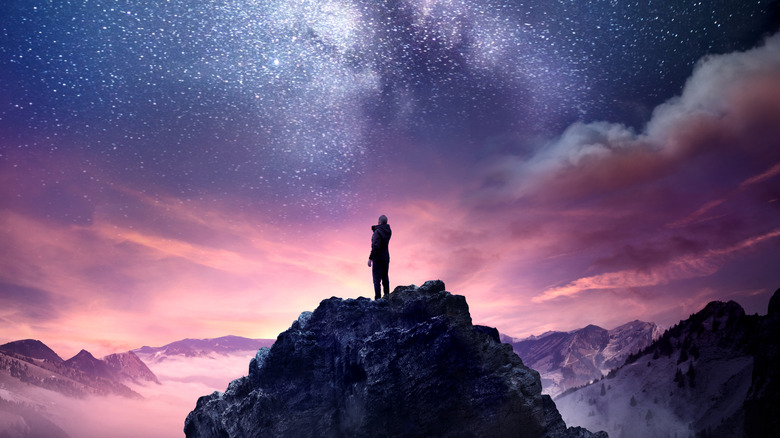The Mystical Origins Of Indigo Children (& Why The Movement Is Riddled With Controversy)
So you know those little online personality quizzes like, "Which 'Star Wars' character are you?" They're similar to the type of entertainment-driven horoscope articles (e.g., "What Mars means for you in 2022!") you might come across here and there, or an informal, unofficial 20-question MBTI (Myer's Briggs) personality inventory that gives you a Jungian moniker like "INFJ." It's a two-minute "get-to-know-yourself" self-help exercise that's as effortless to do as it is easy to question. It's in realms such as these that readers might have come across an eye-catching and clickable term, one that conceals a deeper history: Indigo Children.
Sites like Gaia jump on board without looking back, very sincerely headlining "13 Common Traits of Indigo Children" and then writing, "If you wonder if you might be of this distinct soul lineage, here are a few personality traits that may feel familiar." Traits include, "You have a strong intuition" and "You want to overthrow the man." Scary Mommy takes a more skeptical approach but also includes a full inventory containing agree or disagree statements. Those statements include, "I enjoy knowing why things are done" and "I've partaken in destructive behavior like alcohol and drug abuse." Also, the article says, Indigo Children don't like going to school. So basically 90% of humanity?
In the end, Indigo Children are part-mystical gobbledygook, part-urban legend. They're connected to systems of vague religiosity and actual neurological disorders. But what, actually, are Indigo Children, and why is the notion controversial?
New Age buzzword baby Buddhas
If you couldn't glean so far, an Indigo Child is supposed to be a hyper-aware, ultra-sensitive, super-intuitive, wise-beyond-one's-years child. But we don't just mean that such a kid is ahead of the curve or smart and ill-adjusted. As sites like The New York Times explains, an Indigo Child is supposed to be an incarnation of some cosmic soul, a facet of the divine made not just to manifest on Earth but driven to do so in order to lead humanity to enlightenment. Think of "What if you were mother to the Buddha?" hypotheticals meet Whitney Houston's "Greatest Love of All" lyrics ("I believe children are the future") stirred into a vague cocktail of cobbled-together New Age-ish buzzwords, and you'll start to get a picture of who and what Indigo Children are supposed to be.
Ultimately, we've got one person to thank for spreading the not-quite-purplish notion of Indigo Children: Nancy Ann Tappe. As HowStuffWorks explains, Tappe dwelled in the midst of 1960s and early '70s Californian New Age spiritualism as a self-professed psychic and parapsychologist (a psychologist who specializes in paranormal phenomena). She claimed to see auras around people. These auras, which were the color of indigo, seemed to go hand-in-hand with "a new and unusual set of psychological attributes," as the later 1999 book "The Indigo Children: The New Kids Have Arrived" put it. By then Indigo Children had become the touchstone of a full-blown mystical movement.
Indigo chakras and auras
So why indigo? It sounds more mystical than "Red Children" or "Blue Children," it's true (but maybe not "Scarlet Children" or "Azure Children"). HowStuffWorks tells us that Nancy Ann Tappe, the originator of the Indigo Children legend, described seeing indigo auras around particular children. An aura, for the uninitiated, is a color-based imprint of one's energy, soul, essence, etc., that surrounds the body. Certain psychically endowed individuals claim to visually behold auras with their own eyes (and photograph them).
Aura Aura has an extensive breakdown of auric colors: red, pink, yellow, green, magenta, orange, tan, even rainbow. Each color is associated with certain personality traits. Color location matters, too, like at the throat, heart, left side, right side, etc. There are also auric patterns that emanate from, or orbit, the body. These include beams, orbs, streaks, and whatnot. An indigo-colored aura, per mindbodygreen, indicates psychic clarity, sensitivity, empathy, and more.
Aura colors also relate to chakras and perhaps derive from them. Chakras connect to yogic traditions, which explains the belief in chakras and auras in 1960s California. As Arhanta Yoga explains, the body's energy circulates through seven foci. Each focus corresponds to a different point in the body and different color, e.g., the sacral chakra is orange, and the throat chakra is blue. Indigo/purple is the crown chakra at the top of the head. If energy flows freely through this point, an aura appears indigo, the hue of spiritual enlightenment.
The children shall lead them
At this point, readers can probably envision a number of problematic issues related to Indigo Children. In its most benign form, the whole thing is a distraction and light topic for generating content via factoid-and-quiz articles like that on Know Thyself, Heal Thyself. And of course parents want to believe that their children are capable, special, beautiful, and so on. "Spiritual," "mystical," or "metaphysical" discussions also make for fairly harmless — if poorly defined and potentially deluded — chit-chat. But there's a big difference between this kind of loose conversation and more cultish and usurious aspects that characterize the Indigo Children phenomenon in its most extreme form.
Individuals like Lee Carroll and Jan Tober provide a good example of what we're talking about. As the Center for Studies on New Religions describes, Carroll is a self-described channeler of an entity called Kryon, while Tober is an "intuitive counselor, hands-on healer, channel, meditation facilitator/leader, Reiki Master, co-founder of the Church of Awareness," amongst other things. These two took an interest in Nancy Ann Tappe's original writings about Indigo Children and began running workshops about the topic in the 1970s. Spiritualist Doreen Virtue got on board with her 2001 book, "The Care and Feeding of Indigo Children," and added a bunch of elements to the mix: the Age of Aquarius, Divine Truth, angel therapy, Atlantis, theosophy, interdimensional travel, and more. And now? There's a massive cottage industry of Indigo Children products that wield children for income, as Goodreads shows.
Underlying psychological illnesses
Part and parcel of the Indigo Children thing, if the reader remembers, is disaffection and poor behavior. Gaia quotes "You question authority" and "You want to overturn the man" as evidence of a child being a mystical, interdimensional, uber-conscious savior of humanity. Scary Mommy invokes criteria like, "I was rebellious in school and didn't enjoy doing homework or respecting authority figures" and "I tend to attract emotionally unbalanced people who need healing." LonerWolf goes a bit more macho and cites "You're a headstrong nonconformist" as good evidence of a child being an Indigo Child, especially if described as "naughty," "obnoxious," "disobedient," or "contrarian" as a child or teenager. Know Thyself, Heal Thyself paints a portrait of Indigo Children as having poor attention, low self-esteem, plagued by insomnia and depression, diagnosed with ADHD, and having a tendency to self-isolate.
In other words: All those self-destructive behaviors? Oh no worries, that's just you being a special magic cosmic baby. Your problems aren't problems, they're wonders of the universe just like you. Such absurd contradictions and self-delusions haven't gone unnoticed. The New York Times brings it up, citing Indigo Children magnate Doreen Virtue framing the issue as, "They're vigilant about cleaning the earth of social ills and corruption, and increasing integrity." The Center for Studies on New Religions discusses much the same and points out how Indigo Children fit in nicely with Christianity's vision of a world of eventual and impending peace, especially when blended with American cultural defiance and individualism.
Believers and a born-again non-believer
Aside a mountain of criticism from without, the Indigo Children movement has experienced dissolution from within. As IFLScience explains, Doreen Virtue — the individual who took Nancy Ann Tappe's original ideas and expanded on them — has recanted her involvement in the movement and New Age beliefs writ large. Granted, as the Doreen Virtue website explains, she's affixed herself to another set of beliefs (born-again Christianity), but she's also gone so far as to request that outlets discontinue selling her older, Indigo Children-themed material.
Meanwhile, plenty of people still glom onto the notion that their gifted but unruly child doesn't need behavioral and/or medical attention but is a beacon of hope and "chosen one" to lead a spiritually enlightened humanity, as a 2016 VICE documentary on YouTube puts it. Other YouTube videos on channels like Celestial Inspiration even divide Indigo Children into four different types based on role: humanist, conceptual, artist, and catalyst/interdimensional. It all makes for wonderful, bite-sized, dubiously convenient self-help and article-and-video-feed fodder, which ought to clue people off right away.
So in the end, what are we to make of the whole Indigo Children thing? "The innocence and wonder of children" is a concept widespread to be utterly passé. Children are the future, children are the way, children are the answer, etc. Maybe that's all that Indigo Children reflect: the hope that this is not only true but that we adults haven't messed up kids' chances beyond repair.
